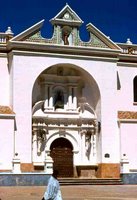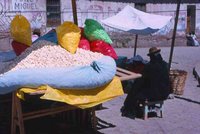

A recent item in the Los Angeles Times reported that $30 of raw popcorn can generate $3,000 in sales at a movie theater concession stand. The Bolivian women selling popcorn outside the cathedral in Copacabana on Lake Titicaca don’t enjoy a thousand percent profit margin, but when the plaza that fronts the cathedral fills with campesinos who come for blessings on their cars and trucks, the popcorn ladies can move more than a few bags of the white stuff.
I bought Adam a red plastic bag of it. Big as his torso. We sat down by the cathedral to people-watch. I scooped a handful of popcorn and discovered it was coated in sugar. I was on vacation, so I kept eating.
Some two dozen members of an extended family, covered in streamers and confetti, sat on the sidewalk outside the cathedral gate near their brand new van, bedecked from bumper to bumper with crepe paper flowers. One of the family’s men stood in front of the van and faced the cathedral. Head bowed and hands clasped in prayer, he asked the Virgin of Copacabana to bless the vehicle and those who would travel in it. While Bolivia’s indians practice the Catholicism brought by Spanish priests and conquistadores, they keep all their bases covered and pepper their Christianity with ancient Aymara traditions and beliefs. So, while one man prayed, the rest of the family ate, imbibed and drizzled drink onto the pavement to honor Pacha Mama – Mother Earth. The offering would help ensure safe journeys in the van and good mechanical karma under its hood.
Inside the cathedral, the Virgin of Copacabana (also known as the Virgen de la Candelaria) reigns. She is the mistress of Lake Titicaca. Copacabana’s population is some 4,000. But on the Virgin's Feast Day in August, over 50,000 people from Peru and Bolivia come to Copacabana to worship her.
She stands, four feet high, inside a niche above the 400-year-old cathedral’s audacious, breathtaking gold and silver altar. But her back is to you. For good luck. (To see her face, you visit a small chapel tucked behind the altar.)
To preserve peace and good fortune in Copacabana, indian lore dictates two things: the Virgin must face Lake Titicaca, and she cannot be moved. The church’s altar faces away from the lake, so the Virgin looks out, not in. Only on weekends and feast days, when the sanctuary is filled with pious pilgrims, do church elders dare turn her around for mass. Service over, before anything bad happens, they spin her quickly back lakeward.
The "cannot be moved" dictate (other than those mass day spins) is immovable, even when the Church's big cheese suggests bending the rules. Years ago, Pope John Paul II visited Bolivia and wanted to see the Copacabana Virgin. He asked that she be taken to the capital, La Paz, where he was staying. Copacabana's religious officials were faced with a no-win situation: on the one hand, the sacred, permanently-rooted Virgin and the fate of the city. On the other, an impossible request from the Holy See’s big boss.
Their flocks saved the Catholic fathers from having to make a messy decision. Campesinos by the thousands descended on Copacabana and surrounded the cathedral. They said "no" to moving the Virgin to La Paz. Church officials took the people’s "no" to John Paul. The pontiff took it in stride, and the Virgin stayed put.
The guy was cool. He probably said, "Never mind. How about some popcorn? And pour some sugar over it, like they do in Copacabana."
